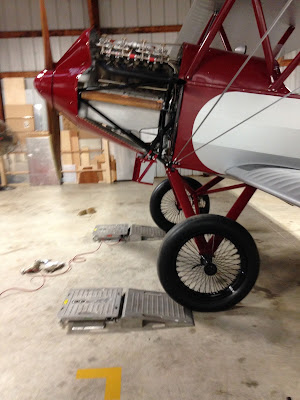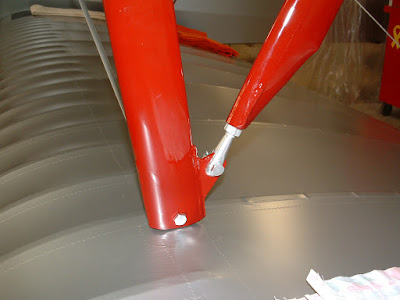- Fabricate the wheel covers
- Fabricate the cockpit combing
- Ground-run/break-in of engine
I'll mention more about those, but here's what I did since the last post.
Javelins for the flying/landing wires were made and installed. I made them from maple and they are attached with rib lacing cord.
These are the inspection covers I made for the upper and lower wings. They go on the bottom near the root of the wings.
 |
| Upper wing inspection covers |
 |
| Lower wing inspection covers |
Clear inspection covers are installed over the aileron cable pulleys on each wing panel.
With the full weight of the airplane now on the gear, I could make and install the bungees. I was fortunate to still have one of the originals - it is shown on the right in the photo. An interesting way to terminate the loop. It is wrapped with copper wire and soldered.
Here are the bungees installed...
And finally, I got the propeller permanently installed along with the spinner cap.
With the airplane fully assembled, it was time for weighing it and completing the weight and balance report.
Here I am hooking up cables and fiddling with the control box.
Getting ready to roll the airplane on the scales.
If you've worked with any airplanes from this era, you'll know that very minimal weight and balance information was provided by the manufacturer. They assumed that the airplane could be loaded to the extremes for which it was designed and still safe to fly.
For this particular airplane, it has a gross weight of 2200 pounds with no CG or CG limits published.
It weighed exactly 1500 pounds, providing a useful load of 700 pounds. I guessed the airplane was going to be 1600-1700 pounds, so I was very happy that it came in at this weight.
It was now time for the mountain of paperwork to be completed so I could schedule the FAA for the Conformity Inspection. For this inspection, the airplane and all the paperwork has to be completed along with the airplane signed off for an annual inspection. Then, an FAA Form 8130-6, Application for an Airworthiness Certificate is submitted to the FSDO. So, here is what I had to have ready:
- All the 337's completed
- Weight and balance report
- Operating limitations
- Logbook entries for the restoration and engine overhaul along with the annual inspection sign-off's
- FAA Form 8130-6
Two inspectors from the Milwaukee, WI FSDO came out this past Friday to look everything over. It ended up being more of a learning experience for them, as they never dealt with an aircraft that has only 3 things on the Aircraft Specification (Type Certificate Data Sheet).
The inspection went very well with no issues found. There is a requirement that they have to see the engine operate, but told them that I was going to wait until spring because of the cold temperatures. When I am ready, they will either come out again, or I can send them a video of the engine running. They will then issue the airworthiness certificate - 90 years after the first one was issued!
The items yet to finish...
Cindy and I are going to make the cockpit combing over our Christmas break from school. I have the original, so it will be a matter of duplicating it with the cobra-grain material that the rest of the upholstery was made from.
Then, I need to make a set of wheel covers which I have already started on. They will look like these in the photo - an inner and outer set of covers that I'm sure will make the airplane extremely fast by reducing drag!
The last thing will be an extensive ground run for break-in and check operating limits. Back in the 20's, Parks College, who was operating a fleet of OX-5 powered airplanes, came up with a break-in procedure that most people still use today. It's what I will use, and want to end up with about 6 hours of ground run prior to its first flight. Being a single ignition engine I don't want to take any shortcuts!
So that's it! I'll put in a post or two on the cockpit combing and wheel covers as well as the first engine run - perhaps a video too.
In the meantime, Have a Merry Christmas!

























































